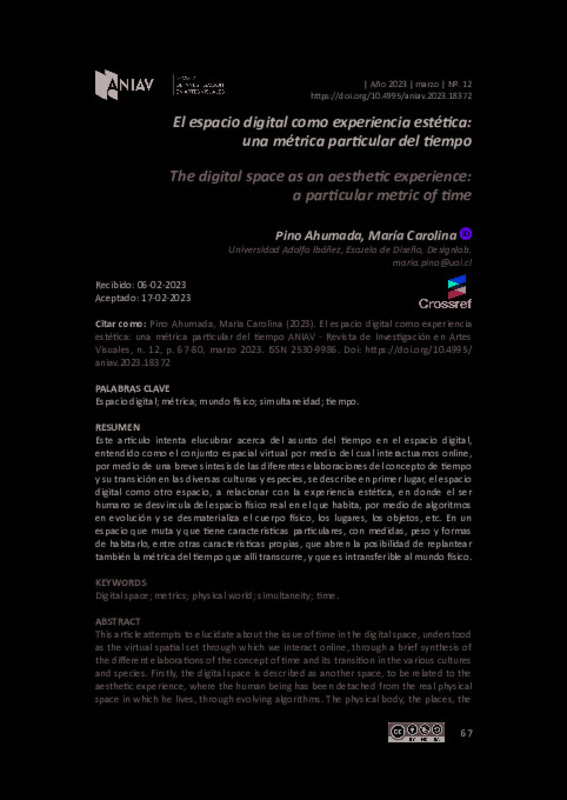JavaScript is disabled for your browser. Some features of this site may not work without it.
Buscar en RiuNet
Listar
Mi cuenta
Estadísticas
Ayuda RiuNet
Admin. UPV
El espacio digital como experiencia estética: una métrica particular del tiempo
Mostrar el registro sencillo del ítem
Ficheros en el ítem
| dc.contributor.author | Pino Ahumada, María Carolina
|
es_ES |
| dc.date.accessioned | 2023-06-13T11:38:29Z | |
| dc.date.available | 2023-06-13T11:38:29Z | |
| dc.date.issued | 2023-03-31 | |
| dc.identifier.uri | http://hdl.handle.net/10251/194151 | |
| dc.description.abstract | [ES] Este artículo intenta elucubrar acerca del asunto del tiempo en el espacio digital, entendido como el conjunto espacial virtual por medio del cual interactuamos online, por medio de una breve síntesis de las diferentes elaboraciones del concepto de tiempo y su transición en las diversas culturas y especies, se describe en primer ugar, el espacio digital como otro espacio, a relacionar con la experiencia estética, en donde el ser humano se desvincula del espacio físico real en el que habita, por medio de algoritmos en evolución y se desmaterializa el cuerpo físico, los lugares, los objetos, etc. En un espacio que muta y que tiene características particulares, con medidas, peso y formas de habitarlo, entre otras características propias, que abren la posibilidad de replantear también la métrica del tiempo que allí transcurre, y que es intransferible al mundo físico. | es_ES |
| dc.description.abstract | [EN] This article attempts to elucidate about the issue of time in the digital space, understood as the virtual spatial set through which we interact online, through a brief synthesis of the different elaborations of the concept of time and its transition in the various cultures and species. Firstly, the digital space is described as another space, to be related to the aesthetic experience, where the human being has been detached from the real physical space in which he lives, through evolving algorithms. The physical body, the places, the objects, are dematerialized in a space that changes and has particular characteristics, with measurements, weight and ways of inhabiting it, among other characteristics of its own, which open the possibility of also rethinking the metric of time that there passes, non-transferable to the physical world. | es_ES |
| dc.language | Español | es_ES |
| dc.publisher | Universitat Politècnica de València | es_ES |
| dc.relation.ispartof | ANIAV - Revista de Investigación en Artes Visuales | es_ES |
| dc.rights | Reconocimiento - No comercial - Compartir igual (by-nc-sa) | es_ES |
| dc.subject | Digital space | es_ES |
| dc.subject | Metrics | es_ES |
| dc.subject | Physical world | es_ES |
| dc.subject | Simultaneity | es_ES |
| dc.subject | Time | es_ES |
| dc.subject | Espacio digital | es_ES |
| dc.subject | Métrica | es_ES |
| dc.subject | Mundo físico | es_ES |
| dc.subject | Simultaneidad | es_ES |
| dc.subject | Imagen-tiempo | es_ES |
| dc.title | El espacio digital como experiencia estética: una métrica particular del tiempo | es_ES |
| dc.title.alternative | The digital space as an aesthetic experience: a particular metric of time | es_ES |
| dc.type | Artículo | es_ES |
| dc.identifier.doi | 10.4995/aniav.2023.18372 | |
| dc.rights.accessRights | Abierto | es_ES |
| dc.description.bibliographicCitation | Pino Ahumada, MC. (2023). El espacio digital como experiencia estética: una métrica particular del tiempo. ANIAV - Revista de Investigación en Artes Visuales. (12):67-80. https://doi.org/10.4995/aniav.2023.18372 | es_ES |
| dc.description.accrualMethod | OJS | es_ES |
| dc.relation.publisherversion | https://doi.org/10.4995/aniav.2023.18372 | es_ES |
| dc.description.upvformatpinicio | 67 | es_ES |
| dc.description.upvformatpfin | 80 | es_ES |
| dc.type.version | info:eu-repo/semantics/publishedVersion | es_ES |
| dc.description.issue | 12 | es_ES |
| dc.identifier.eissn | 2530-9986 | |
| dc.relation.pasarela | OJS\18372 | es_ES |
| dc.description.references | Bachellard, G. (2002). La Intuición del Instante. Fondo de Cultura Ecnonómica, México. | es_ES |
| dc.description.references | Byung-Chul, H. (2021). No-Cosas. Penguin Random House Group, Barcelona. | es_ES |
| dc.description.references | Cuarón, A (Director) (2013). Gravity [Película]. Estados Unidos. https://www.latercera.com/culto/2019/01/21/finales-gravity-cuaron-rechazo/ | es_ES |
| dc.description.references | Einstein, A. (2017), [entrada de blog] El Principio de la Relatividad. https://culturacientifica.com/2017/12/12/principio-relatividad-4-la-version-einstein/ | es_ES |
| dc.description.references | Greenfield, A (2006). Everyware the dawning age of ubiquitous computing. New Riders, CA. | es_ES |
| dc.description.references | Heidegger, M (1927). Ser y Tiempo. Arcis, Santiago de Chile. https://www.philosophia.cl/wp-content/uploads/2019/02/Ser20y20Tiempo.pdf | es_ES |
| dc.description.references | Latour, B. (2004). Politics of Nature, How to bring science into politics. University Press Cambridge, Massachusetts, London. | es_ES |
| dc.description.references | Latour, B. (2018). Dónde Aterrizar, Cómo orientarse en política. Taurus, Barcelona. | es_ES |
| dc.description.references | Quayola (2021). Árbol. https://www.instagram.com/p/COsVHQdpEZp/ | es_ES |
| dc.description.references | Quayola (2021). Scan. https://www.instagram.com/p/CWDjSNioL4F/ | es_ES |
| dc.description.references | Sadin, E. (2020). La inteligencia artifcial o el desafío del siglo. Caja Negra, Buenos Aires. | es_ES |
| dc.description.references | Scott, R (Director) (1982). Blade Runner [Película]. Estados Unidos. https://tenor.com/es/ver/tears-in-rain-like-tears-in-rain-blade-runner-gif-22292703 | es_ES |
| dc.description.references | Steyerl, H. (2014). Los Condenados de la Pantalla. Caja Negra, Buenos Aires. | es_ES |
| dc.description.references | Tiempo, (s.f.) Concepto del tiempo. https://concepto.de/tiempo/#ixzz7M2H9ZvXD | es_ES |
| dc.description.references | Virilio, P. (1998). Estética de la Desaparición. Anagrama, Barcelona. | es_ES |







![HTML file [HTML]](/themes/UPV/images/html.png)

